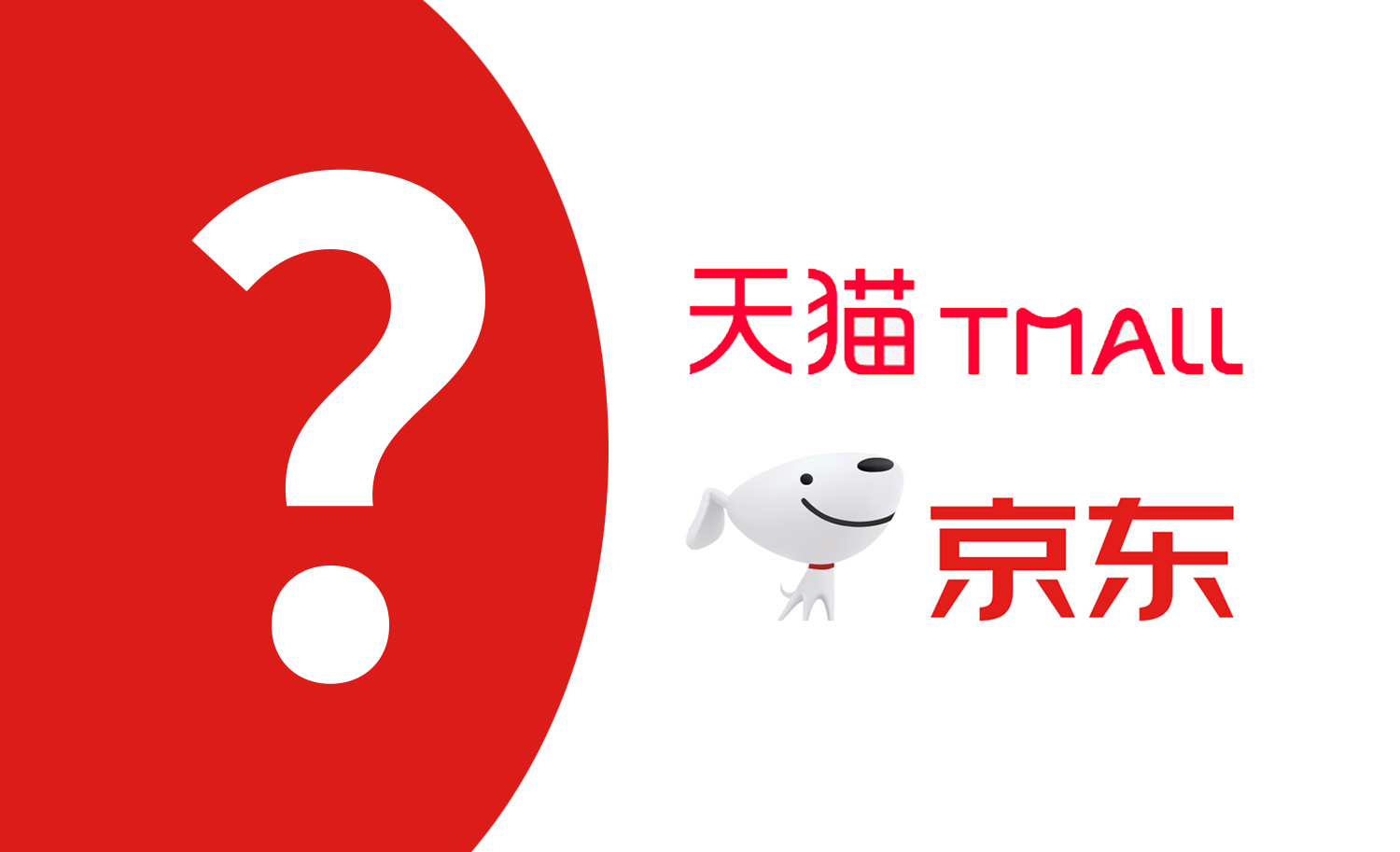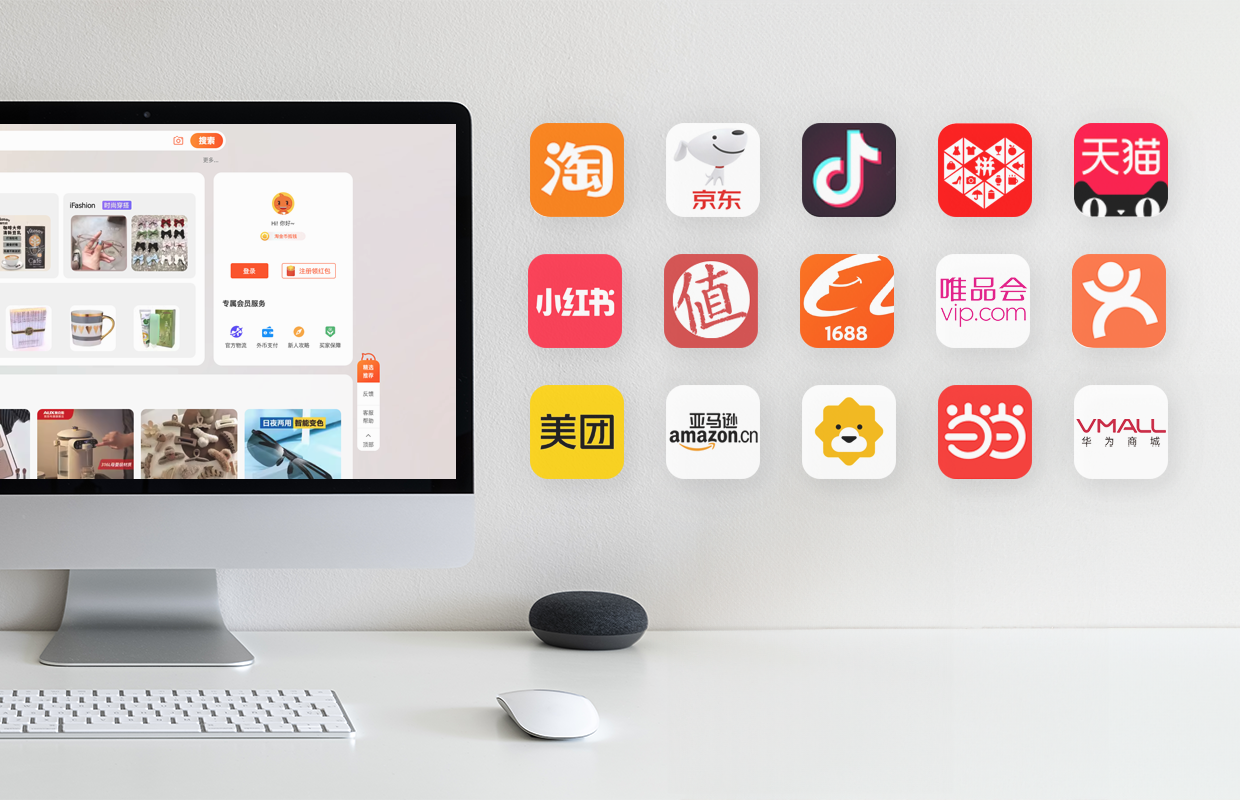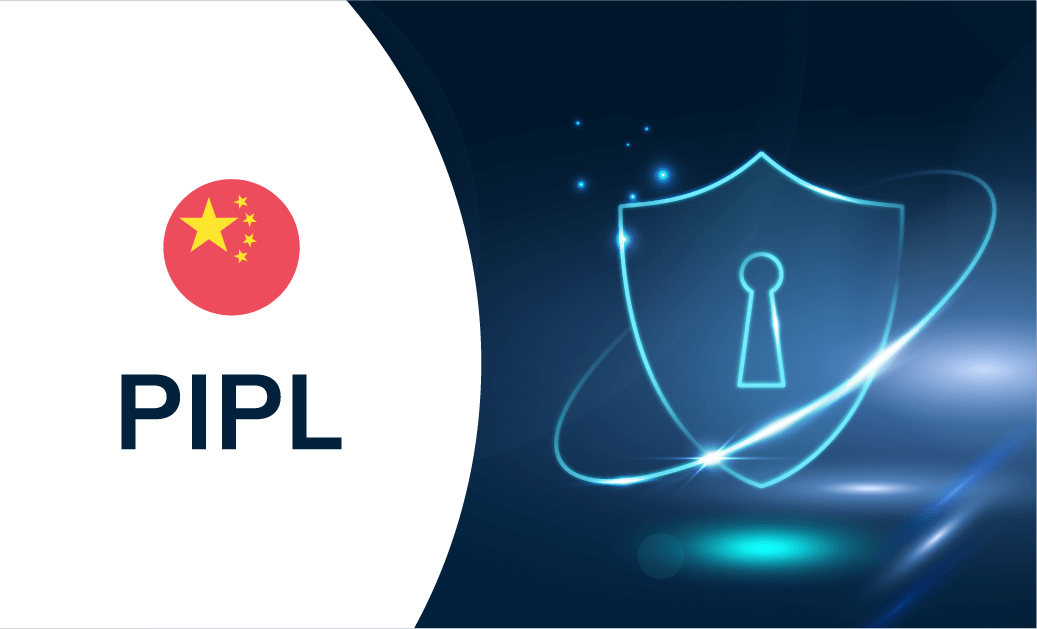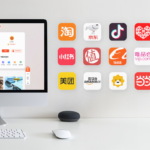China’s internet- and mobile phone penetration rates are 92% and 96%. Furthermore, more than 900 million users daily open WeChat. Foreign businesses looking to do cross-border eCommerce in China will first-hand experience that economic and technological development go hand in hand. So how to incorporate WeChat into your multi-channel eCommerce strategy?
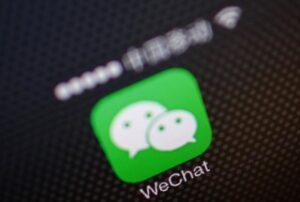 As the biggest consumer market in the world, mobile is one of the most significant contributors to the explosive eCommerce market growth in China. WeChat is a crucial part of the Chinese online landscape and one of the Chinese eCommerce landscapes’ unique features. Released by Tencent in 2011, WeChat was primarily a messaging app but its functions have grown to include WeChat Pay (allowing users to pay their bills without leaving the app), order food and taxis, purchase tickets and much more.
As the biggest consumer market in the world, mobile is one of the most significant contributors to the explosive eCommerce market growth in China. WeChat is a crucial part of the Chinese online landscape and one of the Chinese eCommerce landscapes’ unique features. Released by Tencent in 2011, WeChat was primarily a messaging app but its functions have grown to include WeChat Pay (allowing users to pay their bills without leaving the app), order food and taxis, purchase tickets and much more.
Localization in China thus means adapting and building a multi-channel eCommerce strategy. “Multi-channel eCommerce can help you and your business in many ways: you can unify your content through every single channel, strategise your design featuring different devices, and cover vital features for WeChat, both for communication and eCommerce business purposes”,TMO Group Attended Digital Marketing Event; Explained WeChat eCommerceDuring the presentation, Dominiek has shared his insights about how enterprise can boost its cross-border commerce with multi-channel eCommerce platform. according to TMO Group’s Director Dominiek Pouwer. So today, we take a look at the cross-border eCommerce possibilities that WeChat offers.
Multi-Channel eCommerce: WeChat Stores and Mini Programs
For foreign brands looking to conquer the WeChat eCommerce landscape, one of the most obvious options is to set up a WeChat Store. A WeChat store is basically a web app, a website that can give users an app-like user experience, without needing to download or install anything. WeChat stores can feature attractive front-end development and intuitive UI design. Thus, with WeChat eCommerce the golden era for web apps in China arrived.

Opening up a WeChat Store gives brands a lot of creative space to manoeuvre and interact with their customers. You can redesign and localise the store as necessary so that it fits right in with you other online channels. This option for driving WeChat eCommerce has already been around since 2014. At the beginning of this year, we also produced a piece whichWeChat eCommerce: Is your brand making the most out of it?From H5 Store & Mini-programs, to Service and Subscription Accounts, this is everything you need to know about WeChat's tools for eCommerce. describes all the ins and outs of store set-up in detail.
Therefore, today we want to focus on another important part of the WeChat commercial ecosystem: mini programs. Launched at the start of 2017, mini programs are fully integrated within WeChat. This means shorter loading times and less clicks between product and payment.
Although mini programs had a bit of a rough start, they are now embraced for multiple purposes. Their 'flexibility' allows you to include more diverse features for interaction with customers. Through further development, mini programs now enable WeChat official accounts with functions such as local eCommerce, useful tools, immersive media, etc.
Besides offering an online store for brands, mini programs have become one of their key sources for online marketing and a creative way to reach out to their customers. Being findable and reachable is important and expected by most Chinese customers. Read more on our website on Are WeChat Mini Programs the New Traffic Source?How to embrace the power of the WeChat mini program?how mini programs attract traffic and Are WeChat Mini Programs Going to Boost WeChat eCommerce?Having a deep insight of WeChat consumer groups and fully understanding the WeChat ecosystem; are the key elements for international brands to succeed in WeChat eCommerce marketing.how they can be used for WeChat eCommerce.
Promotion Through WeChat Mini Programs
So how can mini programs actually help you promote your brand and ultimately sell products? It already starts with accessing it. Within WeChat, there are different ways to enter a mini program. According to Aladdin, a leading mini program analytics tool, WeChat now provides 46 ways to enter a mini program. The 3 most common ways are:
- 26,2% enters through a shared user
- 22,2% enters from the discovery bar
- 20,1% enters from an official account
How to attract customers and ensure the right ones are looking at your mini program? We did the work for you and compiled practical advice and examples.
WeChat 'Organic Search’
Factors that influence search traffic for mini programs are:
- Title
- Description
- Keywords
- Amount of users
- Time it has been online
Let’s take a closer look of what you can do for some of these factors to optimise your mini program.
Title
It is important to come up with an easy and catchy title. It needs to illustrate your product and be similar to what your customers are used to call it. The length should be within 4-30 characters (in Chinese).
See below the results of WeChat searches for Gucci, Tod’s and Coach.
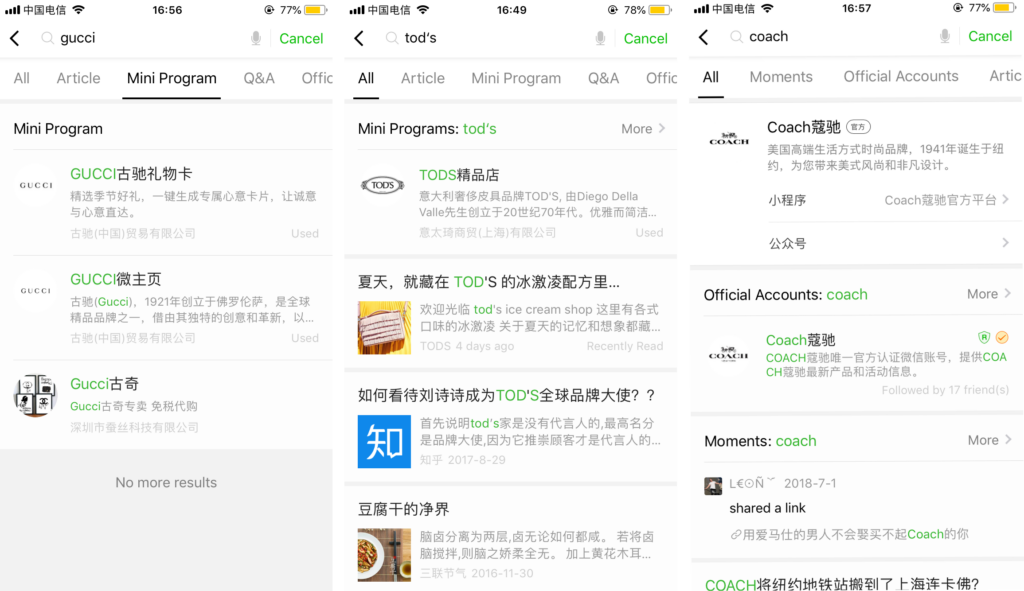
Keywords
In the backend of your mini program you can add a maximum of 10 keywords in the ‘promotion’ module. Based on the WeChat index and relevancy of specific keywords, you can link these with your mini programs.
These are WeChat indexes for Fendi, Dolce & Gabbana
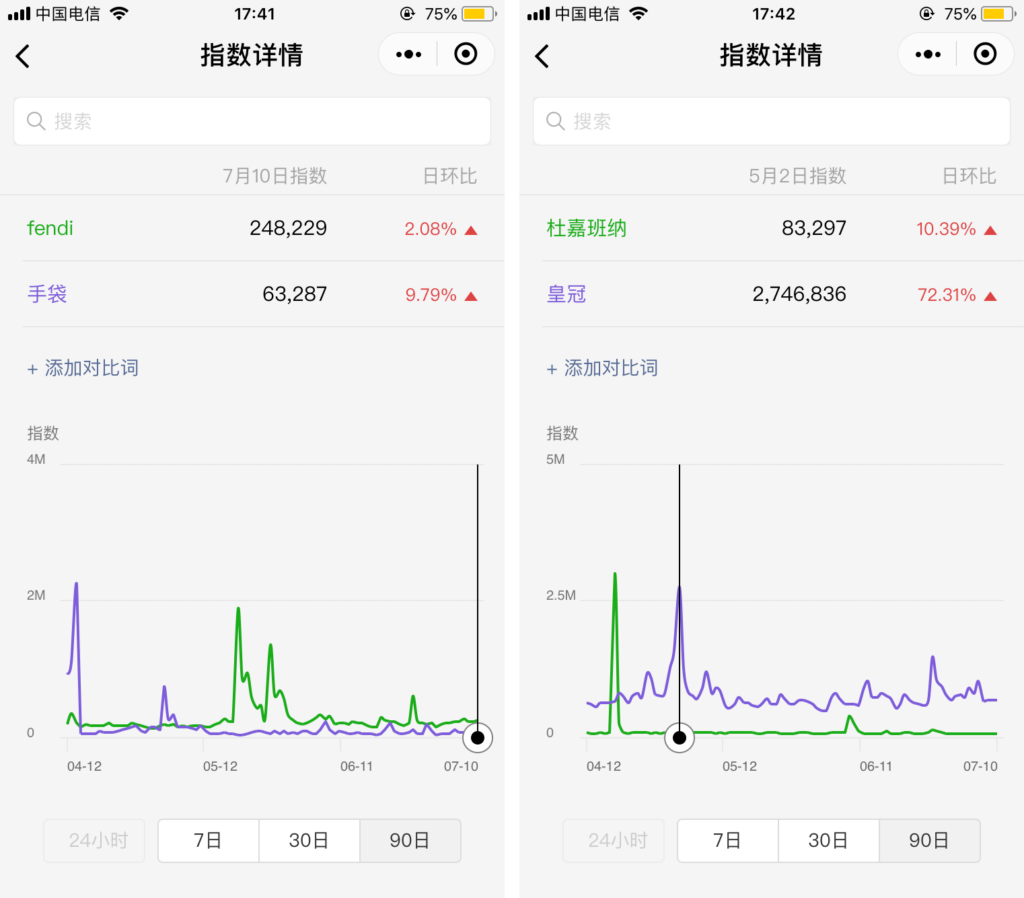
Description
Limited to 120 characters (in Chinese) you can only edit it 5 times per month. The final edit needs to be approved by WeChat. The description will also influence search results and findability.
WeChat 'Organic Traffic'
Besides WeChat organic search, there are many other ways in which brands can reach out to their customers. We take a look at the following aspects:
- Standard template messages
- Mini program notifications
- Payment alerts
- Location-based Search (LBS)
- WeChat menu
- Posts on WeChat
- User sharing on WeChat
- Pull-down chat window
- Official account connection
Standard Template Messages
These are separate textual messages besides the limited amount of posts that WeChat allows official accounts to send out.
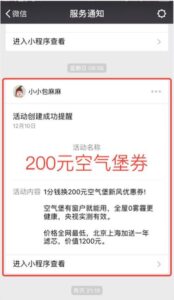
Mini Program Notifications
These are also separate from the limited amount of posts that WeChat allows official accounts to send out.
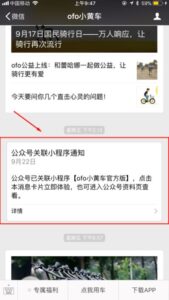
Payment Alerts
You can use payment alerts to create a backflow to the mini program
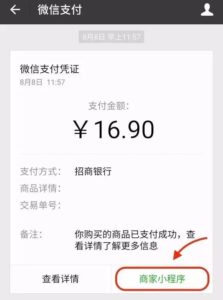
Location-based Search (LBS)
Provide users with your (offline) store info and gain traffic based on LBS
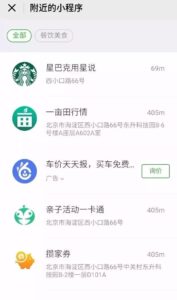
Wechat Menu
Use the followers of your WeChat official account to create a customer flow to your mini program
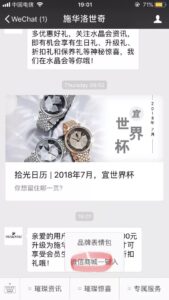
WeChat Posts
Add your mini program to your brand’s official account posts, link up with specific topics and promote it at the same time in a campaign.
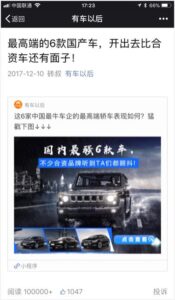
WeChat Sharing
Increase the sharing rate by optimising your title and photos.
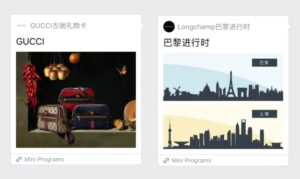
Pull-down Chat Window
Mini programs are ranked according to the rate they are being used
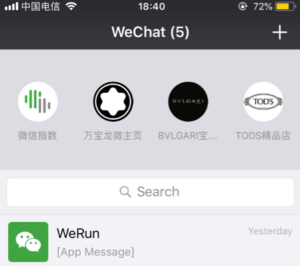
Official Account Connection
Make your mini program directly visible from your official account to attract more attention.
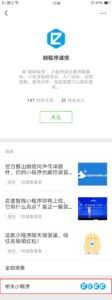
Note: every official account can only link 10 related mini programs and 3 unrelated mini programs.
Mini Programs, Maximum Effects
It is clear that mini programs are hot online marketing channels for many brands. So which brands provide prime examples of successful mini programs? To provide you with even more inspiration to tackling WeChat eCommerce, we take a look at 6 case studies.
Customization
Tailor-made and personalized are keywords for luxury brands. Their products are to be personalised or tailored to fit your lifestyle. Therefore, this aspect is an important one for luxury brands, something they try to exude at all times.
Mini programs can provide a simple and clean environment for customers to personalize their purchases. Below are 3 examples of Longchamp, Pandora and Gucci.
Longchamp
We already paid attention to the “Are WeChat Mini Programs Going to Boost WeChat eCommerce?Having a deep insight of WeChat consumer groups and fully understanding the WeChat ecosystem; are the key elements for international brands to succeed in WeChat eCommerce marketing.Longchamp Customized Boutique Shop” in one of our articles last year. Its WeChat mini program allows users to choose a specific product and personalize it by selecting their favorite colors or even engraving it. They can then pay with WeChat and have the option of getting the products delivered to their homes.
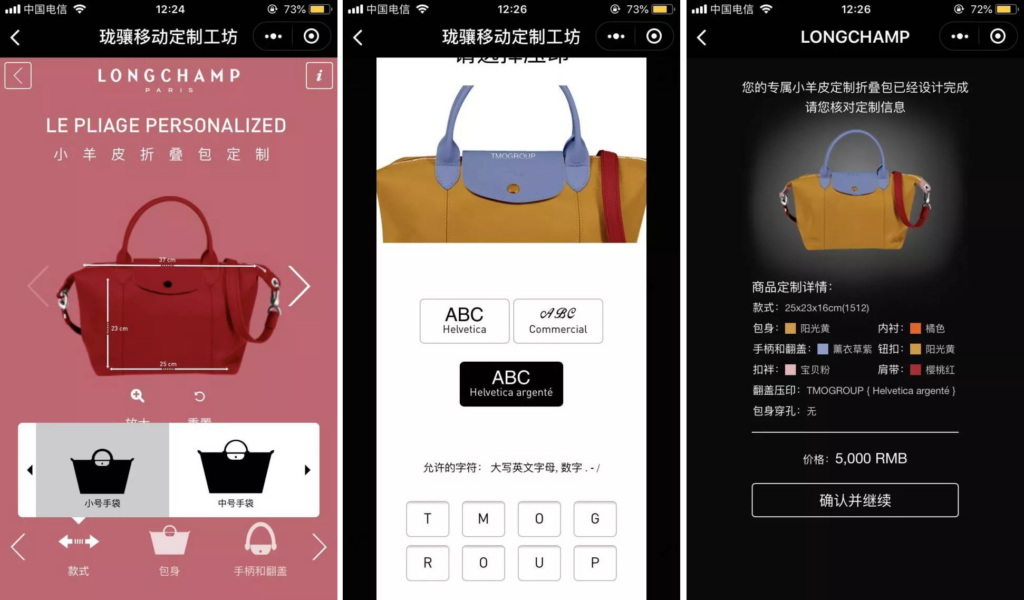
Pandora
Pandora offers customers similar options through their mini program, customers can easily DIY bracelets and add charms. With options of more than 20 accessories, there is more than enough choice for everyone to truly make their own Pandora.
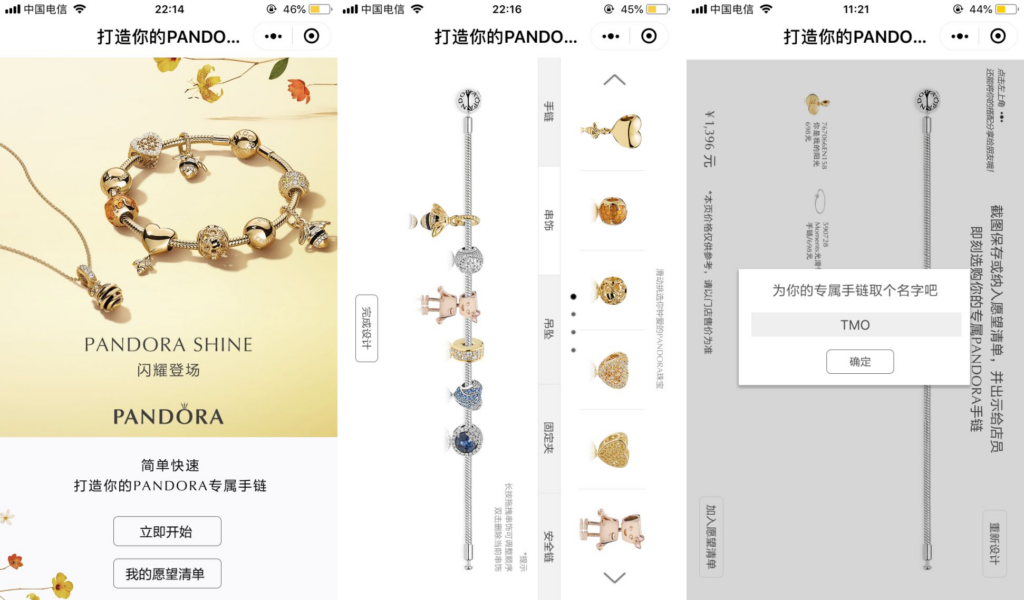
Gucci
Gucci’s mini program allows customers to upload their own photo and edit it with trendy Gucci items. Although it is not a new thing to add stickers or edit photos and share them through social apps, Gucci’s take on this brings a new dimension to it for fashion lovers.
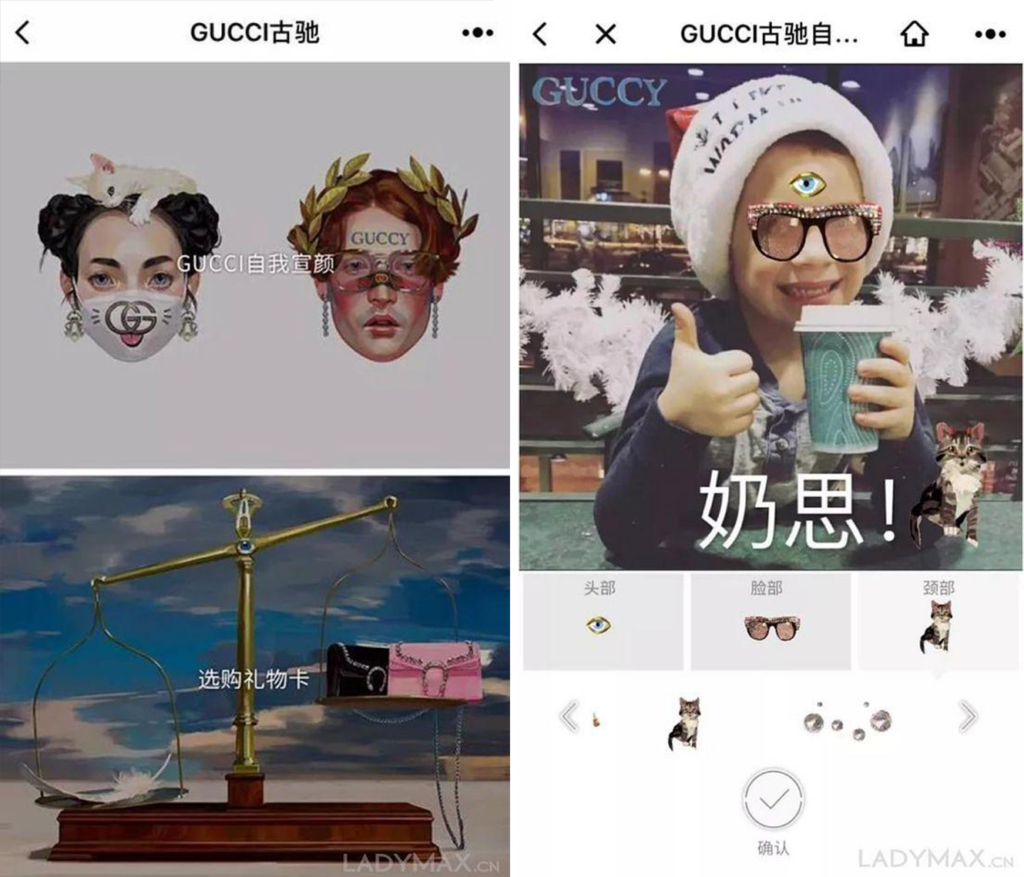
Pop-up Store
A pop-up store is gone in a flash. However, the impression it leaves behind can last far longer than the store ever existed. Key is making good use of scarcity, launch on a specific timing, choose special themes and capitalising on a sense of urgency.
How to combine this in a mini program? Let’s take a look at Fendi and Coach’s examples.
Fendi
Fendi sold their capsule line products through their mini program store for a limited amount of time. For this promotion, they also made use of the less used ‘short video’ feature. This boosted the mini program’s quality and allowed them to better showcase their products. When we took a look to see how they were doing, the store was already empty!
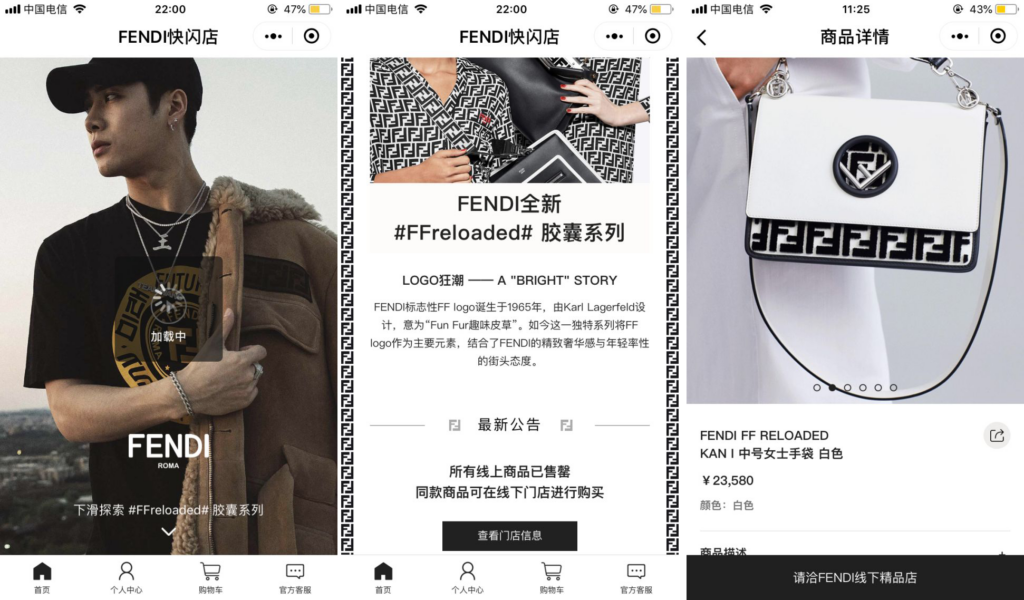
Coach
Coach used their mini program to promote their limited edition collaboration with Xu Weizhou. Large photos from the lookbook were combined with a rolling banner to attract fans. This resulted in a classic example of a celebrity cooperation pop-up store.
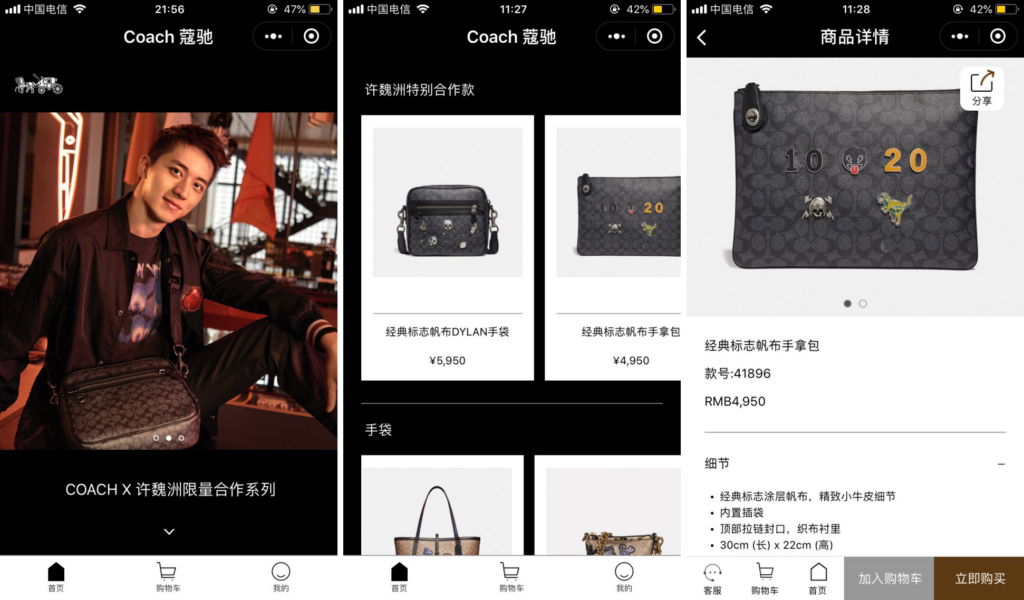
User-Generated Content (UGC)
Already in 2014, we predicted that the future of eCommerce would be in differentiation and individualisation. Developing specific user habits and social sharing are two of the most important strategies. When people actively share products or information, the platform will become more creative and this can again lead to more interest and profits.
WeChat mini programs are well suited for this purpose, as Longchamp’s example below shows.
Longchamp
Longchamp is one of a small number of mini programs that uses UGC content to promote its brand. In their mini program, users are encouraged to upload their selfies, leave comments and ‘check in’. Although these are well-known functions, championed by a fashionable brand like Longchamp it is clear that one does not need to reinvent the wheel to become popular.
At the same time, their community uses quite a lot of Professional Generated Content (PGC) to support its activities. Longchamp continuously generates PGC to enrich its community as well.
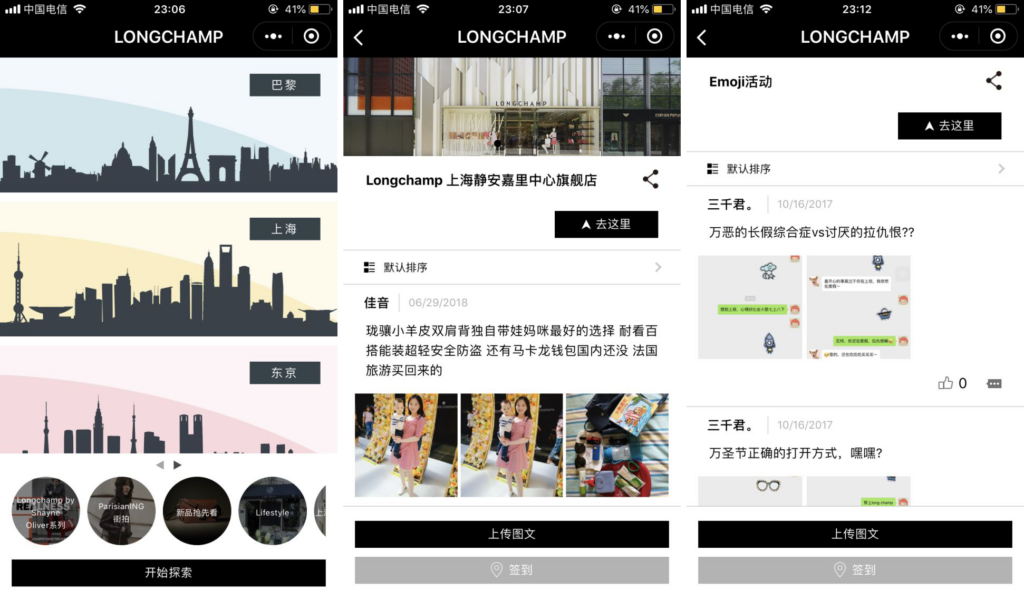
Customer Relation Management (CRM)
WeChat is at its heart a social app. Users like to stay in touch with each other, and brands like to stay in touch with their customers.
This is exactly what Michael Kors is using its mini program for.
Michael Kors
Michael Kors launched a mini program that focuses on membership services, becoming the first luxury brand to do so. In this way, they complete consumers’ offline journey with online care. For example, when consumers are shopping in a Michael Kors store, they can check product details in real-time, review the shopping experience and get after-sales benefits from the mini program.
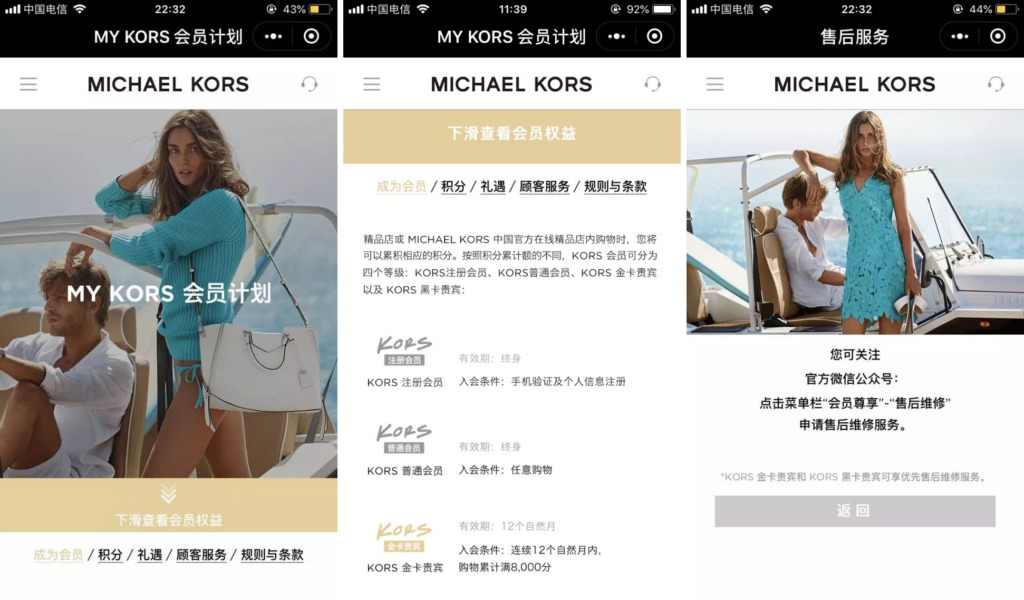
Mini Program Gift Cards
Mini program gift cards are basically WeChat coupons with an added social component. Make everyone happy by enabling gift card purchase and personalisation of the look and message.
Gucci, Dior, Swarovski
These three brands use different approaches to gift cards, but with equally effective outcomes. Customers can choose a look for the card, pick a text for the wish and send it directly to the receiver. With this new way of presenting products, customers are instantly tempted to make the purchase.
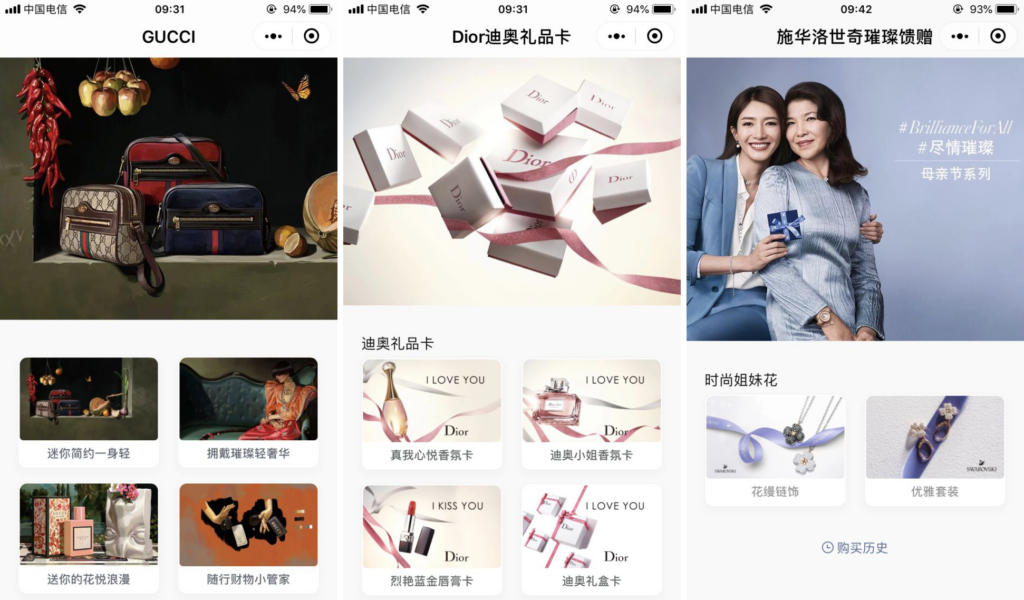
Online store
Using mini programs for showcasing products is done by many brands. However, it is interesting to see that even though mini programs are relatively light-weight, they can offer a full shopping experience. A mini program store can almost rival a full HTML 5 WeChat store.
Longchamp, Tod’s
Mini program stores such as those of the brands above, show the range of possible features and functionalities. These shops all use rolling banners to a certain degree so you can slide down for the menu, browse product categories and product details, choose product standards, add your address and pay.
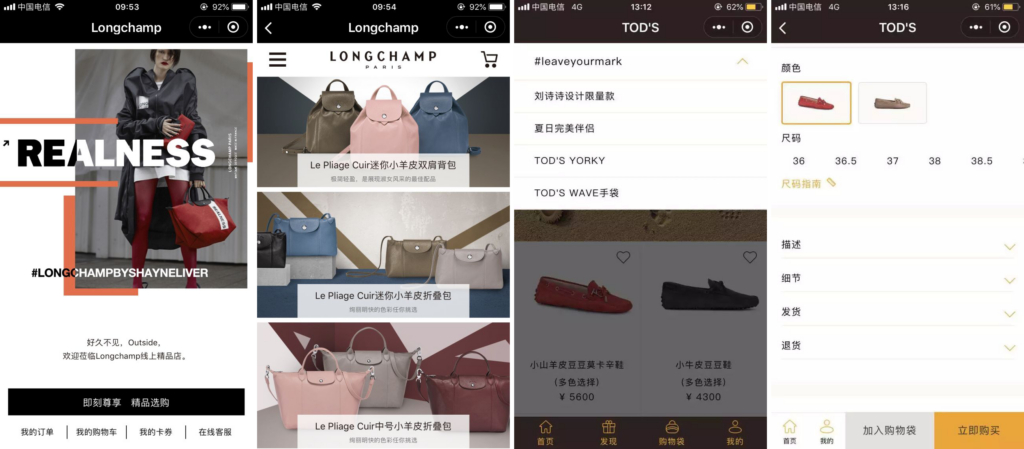
Guiding You to Success
So now you have all the inside info on developing your WeChat eCommerce strategy. It is clear that China’s eCommerce market provides many opportunities. However, capitalising on this potential is not easy and Chinese localisation is of key importance. To help you find your way, TMO Group published the perfect roadmap to get you started in China cross-border eCommerce.
Are you looking for more information and tips on how to start your eCommerce business successfully in China? Then be sure to take a look at the Preview of our China eCommerce Market Localisation Guide. Like what you read? Then you can directly purchase the fullChina eCommerce Market GuideThis in-depth China eCommerce Guide can help your company rise to the challenges of the Chinese market and sell via cross-border. Updated for 2020! China eCommerce Market Localisation Guide here.
The guides are based on our 20+ years of experience and composed by our team of eCommerce market researchers. Be sure to check out our Resources page for the complete series of guides which cover: (A) eCommerce Market Localisation, (B) eCommerce Store Localisation and (C) eCommerce Legal Localisation.


